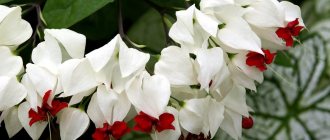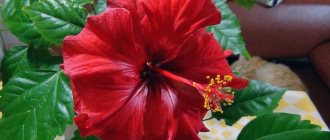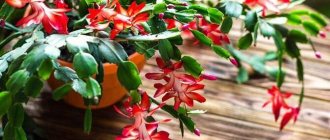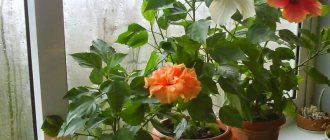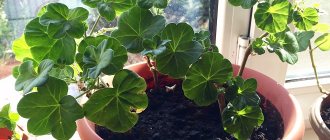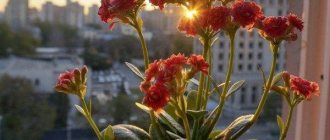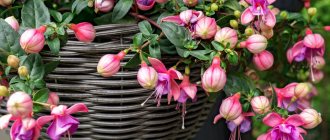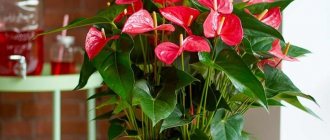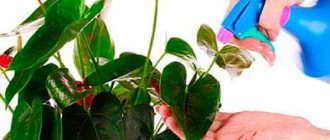Anthurium is a complex and at the same time easy to care for indoor plant. Until a certain point, it was not possible to “tame” the tropical guest, and the crop was grown only in the greenhouses of botanical gardens. The work of botanists was not in vain; many varieties have been domesticated and can easily grow in an ordinary apartment. But, anthurium is valued by gardeners not for its green leaves, but for its riotous flowering. Often the plant stubbornly refuses to bloom after purchase. This means that any rules for keeping anthurium at home were violated. What should you pay attention to and how to fix the problem?
Anthurium bloom
Anthurium is a typical inhabitant of the tropical forests of South America, grown here as a houseplant. Very often, due to the specific structure of the flower, it is called “male happiness.”
Anthurium leaves come in different shapes: dissected, oval, heart-shaped, matte or glossy, and grow up to 40 cm in length. But rarely does anyone buy it because of the beauty of the leaves. The main advantage is the flowers - an inflorescence-cob and a beautiful heart-shaped blanket, which can be red, pink, white, purple, burgundy, with a variety of shades.
Photos of flower varieties
Red anthurium most often appears on sale
Anthurium Otazu Brown with almost brown covers
Utah features purple cob and glossy textured blanket
Anthurium Black queen with black flowers and bright veins
Lady Love very beautiful pink anthurium
Fantasy Love - light pink cob and bedspread in pink, green and white shades, with bright veins
White champion absolutely white anthurium with a light green cob
White Heart anthurium impresses with its bright pink spadix and white heart-shaped spathe
Hawaiian Obake hybrids combine several shades in the bract
Anthurium varieties Tulip have a bract shape similar to a tulip
Princess Alexia Blue amazes with the purity of the color of the blue bracts
Each bud stays open for up to two months, then the color of the cover lightens and the flower dries up. With good and proper care, anthurium can produce flower stalks all year round, remaining decorative at all times. But most often, anthurium blooms from March to November.
The plant itself lives a long time, giving birth to children and growing up to 50 cm in width and 80 cm in height.
Necessary conditions for flowering
In order for your anthurium to regularly delight you with its flowering, you must comply with the following conditions.
Lighting is the most important parameter in care. Anthurium loves bright light, but without direct sunlight. It feels best on the eastern window and on the northern one, but with additional lighting. Light and day length are especially important during the period of bud formation - from November to February. If the plant vegetates during short days at this time, then flowering in the spring may not occur.
Temperature - anthurium does not like temperature changes, drafts and cold . In winter, it is better to keep it at 18–20 degrees, and always away from heating devices. To stimulate flowering, you can place it for 2 months in a room with a temperature of 15–16 degrees, but not lower, and at the same time very limit watering. In summer it tolerates normal room temperature, preferably no higher than 28 degrees.
Watering is regular, the top layer of soil should dry out . Follow the rule: the lower the temperature, the less watering. It is better to place the plant on a wide tray with wet expanded clay to increase humidity, and also periodically spray and wipe the leaves from dust, but at least once a week. Ideally, turn on a humidifier nearby.
Feeding in spring and summer . Anthurium can be fed 1–2 times a month with fertilizers for ornamental flowering plants, but diluted 2 times.
The soil in which “male happiness” grows is also important - it must be loose and breathable. To do this, you can buy ready-made soil for anthuriums or a universal soil for flowers with the obligatory addition of bark or soil for orchids.
If you are afraid of making the soil unsuitable, buy a special soil mixture for anthuriums
In January - February, the flower, previously kept in a cooler room, is transferred to a warm place with a temperature of 24-26 degrees. If there is a lack of light, be sure to supplement the lighting with phytolamps or ordinary fluorescent or cold-emitting LED lamps.
The peduncle can appear from almost any place where there is a growing point: from the center of the shoot or from the side.
The peduncle of an anthurium can emerge from any growth point
Here is an arrow with a painted end, the color of which depends on the color of the bedspread.
The peduncle grows slowly, the bud is closed
A strong, large plant produces several flower stalks at once. They grow slowly, the height of the peduncle can grow up to 50 cm.
We cut off only the wilted parts
Anthurium should not be disturbed or tried to be trimmed unnecessarily; even if the bushes are deformed, shaping is not used and rejuvenation can only be achieved by division. The plant literally needs to be removed only those leaves and inflorescences that wither and dry up on their own. And it’s better not to rush until it completely fades.
From anthurium, you need to remove only those leaves and inflorescences that wither and dry up on their own
“Male happiness” has blossomed. How does a plant need care?
If you become the owner of a flowering anthurium from a store, then your first desire is to transplant it into normal soil. But don't rush to do it right away. First of all, leave the plant for 1-2 weeks to get used to the new conditions. At this time, inspect the plant for hidden pests or diseases. If necessary, introduce quarantine for suspicious flowers, because it is easier to cure one newcomer than to process the entire collection later.
After 2 weeks from purchase, you can safely replant the plant. Almost all anthurium lovers advise replanting it by completely removing the old soil and washing the roots. If the bush is large enough and its age is more than 4 years, then at the same time you can divide the bush into several parts or carefully separate the children. Although it is better to do this before the anthurium blooms.
If you work carefully when transplanting a blooming anthurium, then the flowering will not be reflected in any way.
If you see rotten roots during transplantation, be sure to trim them to healthy tissue and sprinkle with crushed coal. A good stimulation and stress relief after such procedures will be soaking the roots for 20 minutes in the Kornevin solution and then spraying with Epin.
Soaking the roots for 20 minutes in a root solution will help survive replanting
If you got a very sick specimen and had to remove a lot of roots, then it is better to cut off the flower stalks and put them in water, and allow the plant to get stronger. In a vase with water, anthurium remains fresh for up to 2-3 weeks.
I wrote about how to properly transplant anthurium here.
For the first two months after transplanting into new soil, the anthurium is not fed, and then it is fertilized with a complex mineral fertilizer for flowering plants, where there will be a minimum of nitrogen. You should feed 1-2 times a month, diluting the recommended dose by 2 times. Overfeeding anthurium with nitrogen-containing fertilizers can lead to plant disease and the end of flowering.
Experienced anthurium growers recommend regular feeding of flowering plants with Orton Rost
Flowering problems
“Male happiness” is a capricious flower. Even if flower stalks and buds appear on it, they may never open. Let's look at the main reasons for poor quality flowering.
Flowers are drying
If the flowers bloomed more than a month ago, then their drying is a biological process. New buds will be released to replace those that have bloomed, but if it is the young, and sometimes even unopened, buds that dry out, this indicates improper care.
Drying of flowers in the bud phase indicates too dry air
Drying of flowers and buds is primarily caused by insufficient humidity around the plant and lack of nutrition. If the anthurium’s soil dries out completely between waterings, and the room is very dry and hot, then it experiences stress, there is not enough moisture for the growing flowers, and they dry out. Subsequently, drying of the leaves and even death of the plant is possible.
Quite often, the flowers of anthuriums that stand on a south-facing, hot window dry out, even in a warm wind, and even more so in a draft.
When moving a flower from place to place, the flowers or leaves may also dry out.
Anthurium flowers turn green
Very often the color of anthurium flowers changes from bright to green. You shouldn’t be afraid of this - this is not a disease, just a natural cycle of the end of flowering. Usually green flowers are simply cut off. But if all the buds on the plant immediately begin to turn green, this may be a sign of a lack of nutrition when the anthurium completes its growing season and is preparing to rest.
Signs of lack of fertilizer
If a flower does not receive all the required microelements, then over time its leaves wither and turn yellow, and in some places they fall off. In this case, the buds almost do not develop, and the roots stop growing. Even when flowering occurs, the inflorescences grow small and dull. The stems become thinner and harder over time. Even from the photo it is easy to determine that the plant suffers from a lack of microelements.
Important! Depending on which microelement is in short supply, gardeners determine what to fertilize anthurium with.
For example, if a plant does not receive phosphorus, its growth slows down. Over time, the leaves curl and become covered with purple spots. At the stage of acute deficiency, the flower no longer forms buds.
Brown spots on the leaves indicate that potassium supplementation is needed. The main veins and the center of the leaves remain green, but yellowness is observed at the edges. Over time, they die and fall off. When there is a lack of potassium, the plant's immunity suffers the most, since it cannot resist pests.
Calcium is required for root growth and further development of the crop. When there is a lack of it, almost no growth occurs, and a discolored area appears at the base of the leaves. It is also possible for spots to appear and leaves to curl. A lack of magnesium manifests itself through the same symptoms, but in addition the rhizome withers.
With a deficiency of copper or iron, the leaves become almost white, and young shoots are the first to suffer. A lack of zinc leads to light spots appearing near the veins, and the leaves themselves decrease in size.
Care after flowering
With good care, anthurium blooms for a long time, begins in March and ends with the arrival of autumn - in October - November. When the last flower dries, you need to trim it and place the pot in a bright but cool room without drafts. Such a place can be a bright windowsill, where the temperature is kept within +16...+18 degrees. Watch the cracks in the window carefully; even a small draft can destroy the plant.
A small draft from a crack in the window almost destroyed the anthurium
Place several thermometers near the pot to monitor the temperature, which can vary greatly on the windowsill.
In dried soil, anthurium will suffer less from the cold than in wet soil.
The plant should be watered extremely rarely during this period; there is no need to feed it. The ambient temperature should be increased at the end of January; the anthurium begins to wake up after winter and lay flower buds. It is very important that there is at least 12 hours of daylight.
Incorrect lighting
When trying to figure out what to do when anthurium is not growing well, the first thing you should pay attention to is lighting. The plant is distinguished by its love of sunlight, but does not tolerate prolonged exposure to direct rays on its leaves. In places where it grows naturally, the light of the sun passes through the foliage of trees, scattering sufficiently, so similar conditions must be created indoors.
A serious mistake is to install the pot in the sunniest place in the apartment. In this case, the leaf plate will get burns, turn yellow and fall off over time. A similar situation is observed when placed in the back of the room, where there is practically no light.
The ideal option for installing an anthurium pot would be a window on the west or east side of the house. This will allow you to receive a sufficient amount of lighting both in summer and winter. In the middle of the cold season, it would not be superfluous to organize artificial lighting.
Reasons for the lack of flowering of anthurium
Many gardeners complain about the lack of re-blooming in purchased anthurium. They replant, water and spray, but flower stalks do not appear.
The main reason for the lack of flowering is the unsuitable conditions created for the plant:
- anthurium is too young;
- too bright light or lack of lighting;
- unsuitable temperature: too hot or cold;
- a very large pot or improper soil;
- irregular or excessive watering;
- insufficient humidity in the room;
- too poor soil, lack or excess of fertilizers;
- roots are damaged during transplantation;
- drafts or changing the location of the pot;
- diseases, presence of pests;
- pollinated flowers, seed setting, presence of wilted flower stalks;
- wrong wintering.
What to do if the plant only produces leaves
When transplanting anthurium, gardeners often select the wrong pot, choosing one that is too large. In this case, the anthurium begins to grow in width, produce new leaves and children, but it will not bloom until its roots entwine the entire earthen lump. Therefore, take a pot 2–3 cm larger than the previous one.
To flower, anthurium needs a tight pot, take this into account when replanting
When feeding anthurium with fertilizers with a high nitrogen content, flower stalks also do not form, but the green mass grows.
Do not use fertilizers “For ornamental foliage plants” - your anthurium will only produce leaves
If the anthurium bloomed, but suddenly stopped, you may have increased watering or decreased air humidity.
Anthurium is frozen: it does not grow and does not bloom
Most anthuriums stop growing and blooming after improper or rough transplantation, when the roots of the plant were damaged.
If the plant is planted in unsuitable soil, the anthurium will not develop successfully either. The soil mixture must have coarse fibers, loose, breathable, with 2–3 cm of expanded clay at the bottom of the pot.
Useful tips from experienced gardeners
When growing anthurium, experienced gardeners give the following useful tips:
- Ash, chalk and lime should not be added to the nutrient soil for planting this indoor flower. Application of nitrogen fertilizers causes strong foliage growth, but the plant stops blooming.
- Old anthuriums need to be renewed with apical shoots. When transplanting a heavily overgrown plant, remove the side shoots, which can be used to propagate the flower.
- Be sure to promptly cut off faded buds. A softener should be added to the water for watering and spraying, since this indoor flower prefers an acidic environment.
- To maintain the required humidity, if it is not possible to spray frequently or the air is too dry, you can place the flower pot in a tray with wet pebbles. The pebbles evaporating from the stones will maintain the required level of moisture.
- Inspect the flower for pests and diseases to provide timely assistance.
- If no measures help, then you can try to artificially stimulate flowering. For this purpose, at the beginning of spring, water the flower with soft, lukewarm water in a volume of 50 ml. Then, after 7 days, water is poured into the tray of the pot at a temperature of about +60 °C. The pot should have a thick layer of drainage to prevent the roots from getting burned. After another 7 days, the procedure is repeated. This effect helps the plant awaken more quickly to its active life stage, and it will certainly produce abundant color.
Little tricks to stimulate flowering
So, we have found out the main reasons for the lack of flowering of anthurium. But what to do if all the conditions are met: the pot is cramped, the soil is correct, the light is bright, diffused, watering is regular, the air humidity is high, the winter temperature was low? There is only one answer - stimulating flowering by creating a stressful situation. And pouring the earthen clod with hot water, heated to 40–50 degrees, helps with this. It is important to use this technique only once.
Fertilizers for anthurium
In nature, anthurium grows on the roots of trees and even on branches, so it takes all its nutrition from moist air. Therefore, many gardeners also do not feed their anthuriums, but make up for the lack of nutrients with good soil and frequent replanting.
It is better to use liquid fertilizer diluted 2 times for flowering plants that contain less nitrogen than phosphorus and potassium. That is, if the package says to dilute a cap of fertilizer in a liter of water, then for anthurium you dilute the same cap in two liters of water.
To stimulate flowering, you can periodically spray with a solution of Epin, Bud or Ovary.
For long-term flowering, you can spray the inside with Bud solution, starting in February
And after transplanting, water with Kornevin or Zircon.
Stability is the most important thing
For anthurium, you need to find a permanent place with almost unchanged conditions - constant temperatures, gentle ventilation, without any sudden changes in living conditions. They do not like drafts, the influence of air conditioners or radiators, or moving to balconies. It’s not worth taking them out into the fresh air “for company” in the summer along with other indoor crops, because their temperature minimum is quite high.
Anthuriums are thermophilic so much that even a cold snap of up to 18 degrees (for Scherzer’s anthurium - 15 degrees) will harm the plants. You need to protect anthurium from hypothermia, especially the earthen coma, all year round. They tolerate heat only with high air humidity; ideal temperatures are from 18 to 25 degrees.
